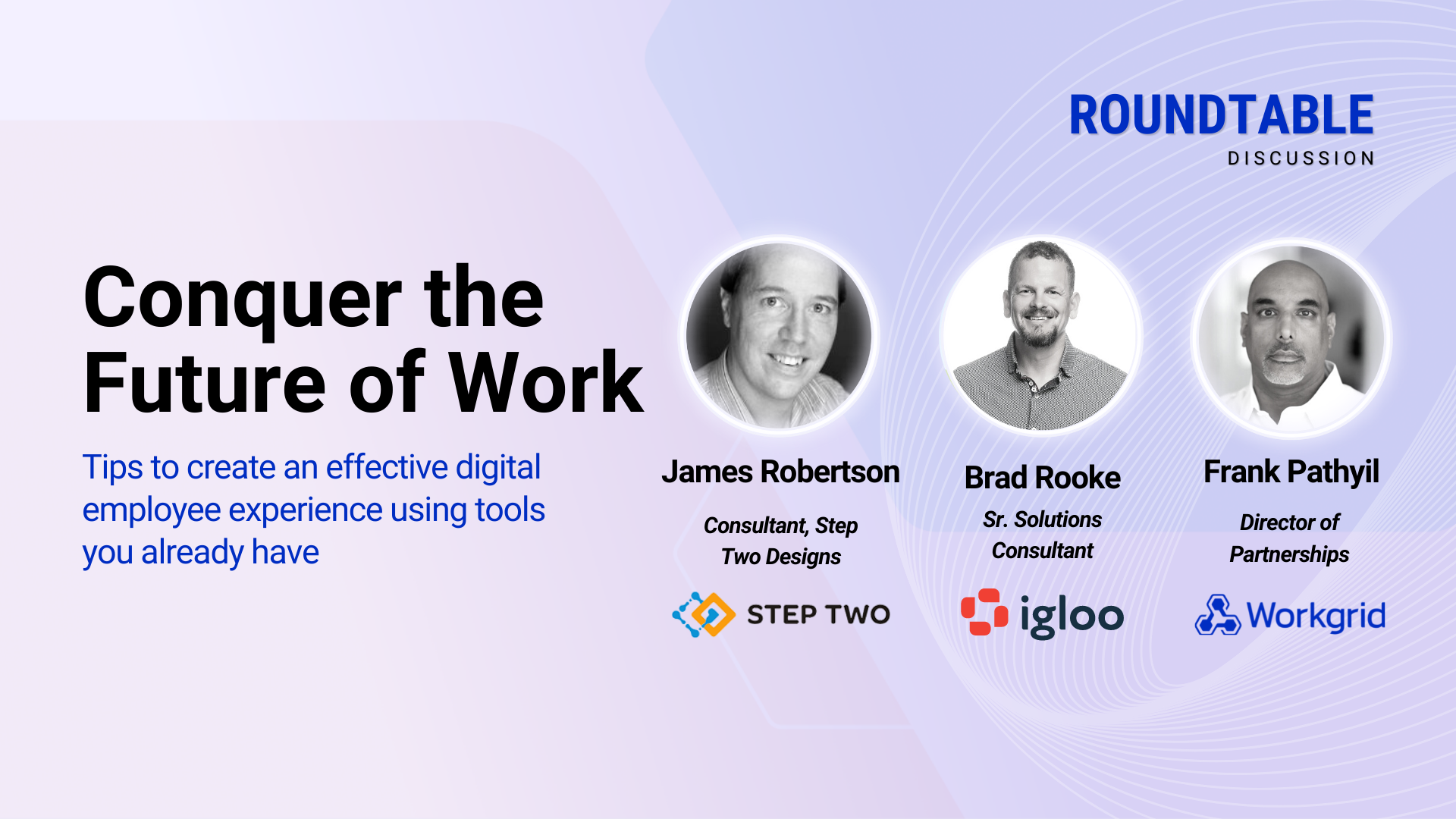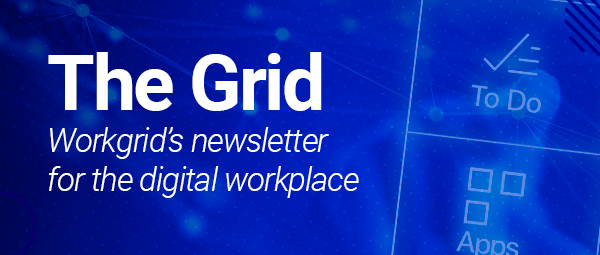I recently had the chance to sit down with James Robertson, consultant and founder of Step Two, and Brad Rooke, senior solutions consultant for Igloo Software, to talk about the state of the digital workplace.
As you can imagine, we had a lot to talk about, specifically how the intranet, digital workplace, and digital employee experience (DEX) all need to intersect if organizations are going to thrive in the coming years.
Here are my thoughts on that discussion…
Setting the stage - how intranets, the digital workplace, and DEX fit together
Before we get going, let’s clarify some myths and misconceptions, starting with the intranet.
The intranet has been the focus of a lot of speculation and debate in recent years. Is it alive? Is it dead? Is it just another name for the digital workplace, or is it just the front door to it? Or maybe it’s more of a digital workplace mudroom that we can convert into a three-season sun porch once the kids go off to college…
We all agreed that, while the world has changed, intranets are definitely still a thing, one component of a full set of digital tools, platforms, and systems that support work and the digital workplace.

Intranets might not be trendy or sexy, but when done well, they're still a tremendously important part of the digital workplace ecosystem.
James Robertson, Owner, Step Two Designs
And what about the digital workplace? That concept has been shrouded in some confusion as well, particularly around the notion that it’s a singular “thing” that can be purchased and implemented.
We all agreed that a digital workplace isn’t something you can buy or implement. It’s the result of the tools you’re already using to help employees get their jobs done. That means that all organizations have a digital workplace. The only question is, is it one that’s been built with strategy and intent, or has it sprung up accidentally, the result of hundreds of disconnected decisions made across the organization?
Companies with a digital workplace that falls into the latter category are likely experiencing some growing pains right now, given the huge influx of new tools in recent years, driven by the shift to remote work.
![[asset] digital friction app overload](https://images.ctfassets.net/z7p73u8c0thn/2wDbjak97uW2ui2s9p6mK/ad729fc2fb001fdb3a9450c27eedabca/digital_friction_app_overload.jpg?w=780&h=400&fl=progressive&q=60&fm=jpg&bg=transparent)
The average company maintains 651 SaaS applications — and, on average, adds ten new applications to the stack every month. (Source)
These new tools have gone a long way toward closing the gap between consumers’ digital experiences and those in the enterprise. But they’ve also introduced high levels of complexity. Lots of places to go to find information and complete tasks. More places to collaborate and communicate. Multiple steps for routine tasks.
More channels. More noise. More frustration.
Basically, advancements in technology have taken the digital workplace further away from where it really needs to be for an optimum digital employee experience (DEX).
Great digital workplaces should deliver a DEX that’s:
Seamless
Frictionless
Productive
Usable
Most organizations don’t come even close to delivering this type of experience. They likely don’t even know much about DEX or understand its importance in the grand scheme of things.
So let’s fix that.
What is DEX, where did it come from, and why should we care?
DEX is a concept born from the idea of customer experience (CX). The concept is simple. You need a good CX to have a viable business, and to have a good CX, you need happy, engaged employees. This understanding of the customer experience has given way to the general awareness of employee experience as a whole, and now specifically to the digital employee experience.
As for what it is:
"The sum of all the perceptions that employees have about working with the technology they use to complete their daily work and manage their relationship with their employer across the lifecycle of their employment."
Forrester, Digital Employee Experience Definition
Recognition of the importance of DEX is steadily gaining traction, but it is still a workplace challenges as seen in Step Two’s global DEX survey from 2023…
Only 14% of frontline staff surveyed reported a good or very good DEX
35% rank DEX as extremely important (down from 45% in 2021)
So now that we’re clear on how all the pieces fit together, let’s talk about the state of the industry.
Top drivers for the digital workplace and DEX
While every organization has its own motivation for wanting to improve their digital workplace and DEX, three drivers are common across organizations of every type:
Attracting and retaining talent
Increasing productivity
Culture
Attracting and retaining talent
Giving existing employees a reason to stay while also attracting quality new talent are both critically important, especially as more and more people move out of the workforce. The quality of the digital workplace and DEX that organizations can offer employees will play a significant role in organizations’ success in this area.
Increasing productivity
The dispersal of applications and knowledge – having resources located in different places all throughout the enterprise – is a very big problem for organizations. It’s becoming imperative to simplify the digital experience so employees can have more time to focus on the high-value, meaningful work they were hired to do.
Culture
The culture of the digital workplace has grown in importance as distributed workforces have become more the norm. Because the digital workplace is often the only connection point employees have with the organization, getting the experience right is critical. Unfortunately, that’s historically been one of the weak spots in terms of digital tools, leading to frustration, disengagement, and, in extreme cases, leaving the company entirely.
So how can the intranet help companies achieve improvements in these areas?
The role of the intranet in DEX
The discussion of how big a role the modern intranet should play in DEX was an interesting discussion. The panel and I are obviously all biased towards the importance of the intranet, so we tried to play devil’s advocate and consider the question, “does the intranet matter at all?”
It isn’t as clear cut as you think.
The people who are going back to the office don’t necessarily need the intranet as much as their remote counterparts. Their employee experience is, by default, a richer, more multi-dimensional experience because they’re surrounded by the benefits inherent in the corporate workspace, such as signage for communication, face-to-face interactions for collaboration, culture, etc.
But most people aren’t going back to the office - at least not full time. And this hybrid trend is expected to continue.
![[asset] office-cubicle-stock-photo](https://images.ctfassets.net/z7p73u8c0thn/7Fmz7ip4kxXtLQA7KXNJkY/dc5696741832230a0304782f4e9fa002/office-cubicle-stock-photo.jpg?w=1200&h=675&fl=progressive&q=60&fm=jpg&bg=transparent)
Gallup estimates that of the 70+ million U.S. workers who can do their job remotely, only two in 10 are currently working fully on-site. (Source)
For employees who spend most of their time working remotely, the intranet is often their main point of connection with the organization as a whole. Their resource for information, communications, culture, and collaboration.
Because of this, the intranet should be viewed as a mission critical resource for organizations.
But it can’t just be a passive repository of pretty pictures and outdated information. It’s got to provide value to the people who need it the most. When done right, the intranet should serve as the jumping off spot where employees start their days, as well as a resource they visit throughout the day, and their last stop before logging off for the day.
"I cover this in my book, ‘Essential Intranets.’ Most intranets are there of course. They’re available. But you wouldn’t cross the street to use them, so I like the idea of thinking of it as a mission-critical tool. The intranet has to be integral to day-to-day work and directly supporting core business."

James Robertson, Owner, Step Two Designs
Just consider the impact a modern, intelligent intranet would have on a process like onboarding.
Given the prevalence of dispersed workforces, there are growing numbers of employees who may never see the inside of the office. With the right intranet in place, the process of onboarding wouldn’t just be more streamlined, it would also be more engaging, delivering support for organizational culture and creating the welcoming first impression new employees need to feel like they’ve made a good decision in joining the organization.
Apply that same thinking to other mission-critical processes and the value and necessity of the intranet grows even further.
To learn more about the importance of the intranet in the digital workplace, check out this guide, How the Intranet Can Improve the Digital Employee Experience.




